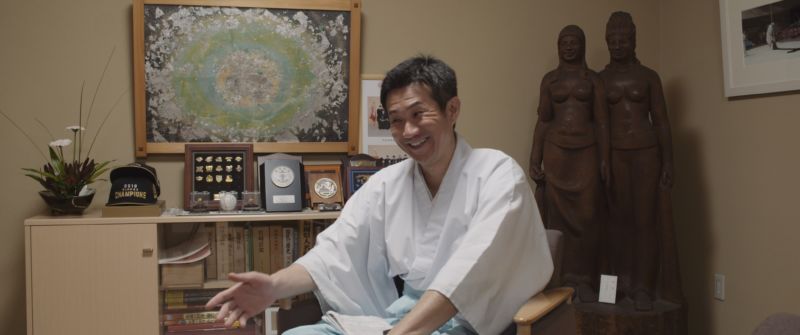“Shinto is not a religion. It is a spiritual culture nurtured for centuries by the Japanese people.”
So begins the trailer for a documentary film with the working title of Shinto: Kami no Michi by Polish director Tom Sajewski. His latest project is inspired by the animist roots of Shinto and the beauty of the shrines integrated in nature.
The documentary was made with the cooperation of a priest from Hakozaki Shrine and a priestess from Dazaifu Tenman-gu, both in Fukuoka. They exemplify the hereditary principle that remains very much a part of the modern priesthood, since in either case they belong to the families that run the shrines. They are the main characters in the film.
For the trailer Sajewski interviewed the priestess, and in answer to the question as to what is Shinto she responded with the quotation above. Of all the hundreds of definitions put forward over the years, it is one of the most apt and succinct that Green Shinto has come across. Like the gateless gate at the entrance to shrines, Shinto is something of a religionless religion.

Asked about the content of the film, Tom Sajewski writes as follows:
An interwoven story of a Shinto priestess Hiroko and priest Kazu set against the unprecedented event of the abdication of Emperor Akihito in 2019.
Shinto has been largely inaccessible to documentary filmmakers until now. The film follows the public and private lives of two Shinto priests, revealing their joy and humor and dedication but also showing the inner workings of a uniquely Japanese philosophy.
To see the trailer for the film, please take a look at the following…
https://vimeo.com/378099156
(Though the shooting for the film is finished, Sajewski is looking for investors or co-producers for the post-production stage, such as the editing, etc.)
*****************
Click on Dazaifu Tenmangu for a Green Shinto posting.
Contact Tom Sajewski directly to be involved with making the film.

Considering that the human soul is a spirit and a Japanese dead soul is virtually identical to its living counterpart (it looks the same, has the same character and even eats and feels lonely), I cannot help wondering if using the word spirituality in this context is wise.
I also wonder what the Japanese original was. Translating Japanese is always tricky, in these cases doubly so.
Thank you Francesco for the comment, though I’m not sure I fully understand your point. I have no idea about the original Japanese, but spirituality doesn’t seem odd or erroneous in the context. Perhaps you could elaborate? (As for the dead being virtually identical to the living, doesn’t that overlook the fundamental difference between a ‘polluted’ material world and the perfect purity of a world without form.)
Thank you for your comments.
The translation was checked & approved by the shrine.
Here you can watch the trailer with Japanese subtitles: https://vimeo.com/378099055
I mean that spirit in the European sense is one thing, in the Japanese sense another, to the point that I cannot think of an exact equivalent in Japanese of the English term. That is why I would like to know what she said in Japanese. Spirituality is whatever has to do with the spirit, so what you mean with spirit is of paramount importance.
Mitama? But Mitama is a very different concept, hardly the same thing. You can even see it as two souls, aramitama and nigimitama, as did Motoori Norinaga.
If we are talking of the soul of an ancestor, then it is an entity that needs to eat, sleep, have a home. You have to feed your dead, and that is what the Japanese do every morning in front of the butsudan. If you lose a hand, so does your soul.
In either case, a Japanese spirit is an invisible but physical entity.
Thus, it seems to me that using the same term is a serious risk of confusion. European spirituality has nothing to do with the material world, and attempts to transcend it.
Dear Francesco,
Here you can watch the trailer with Japanese subtitles (this is the original version): https://vimeo.com/378099055
If the English equivalent is not close enough, how do you propose it should be translated into English?
The English translation is very literal and accurate. The Japanese original phrase is “seishinteki na bunka” 精神的な文化 (lit. Spirit-adjective marker-culture). The word “seishin” (spirit as in spirituality) is defined as the workings of the heart (kokoro no hataraki) if you look it up in a Japanese dictionary. You could probably argue it has a slightly more psychological connotation than English term spirit. For example, the term shinri 心理 (the “psycho” in psychology (shinri-gaku)) is also defined as the “workings of the heart” in the dictionary.
The idea that Shinto is not religion, but rather culture, is very common among Shinto priests in Japan.